Report and photographs by Tracey Dunn on the Housing Justice Conference held at Friends Meeting House Liverpool on 11th and 12th May 2018
With cuts to Housing Benefits, housing injustices, sanctions, exploitation, evictions, no rent caps and more..what does housing justice look like? Eviction watches are becoming commonplace where locals literally block the way to prevent the bailiffs from entering. Issues like Grenfell where profits were put before the safety of the people and the governments plans for more privatisation and deregulation will erase our rights to a place to live even further. Activists, housing campaigners, researchers and others met for 2 days to demand housing justice. Here are a few speakers and filmmakers from the first day.
Resisting Demolition
Margaret Jaconelli, Glasgow Housing Campaigner
Chris Leslie, Filmmaker – www.chrisleslie.com
Margaret Jaconelli purchased her flat in Ardenlea Street, Dalmarnock in the East End of Glasgow in 1976 and was told her home would be compulsory purchased (CPO) by the council to make way for the 2014 Commonwealth Games.
Dalmarnock was in a sorry state of dereliction, the population of up to 50,000 people had reduced to 1,700 as people moved away in the hope of work, a better life with play areas for children and such like. The houses in the area had been left to rot for 20 to 30 years and residents were losing all their rights. At one point Margaret was spending up to £140 a week for electricity and gas to keep warm as the flat above hers was empty with no windows.
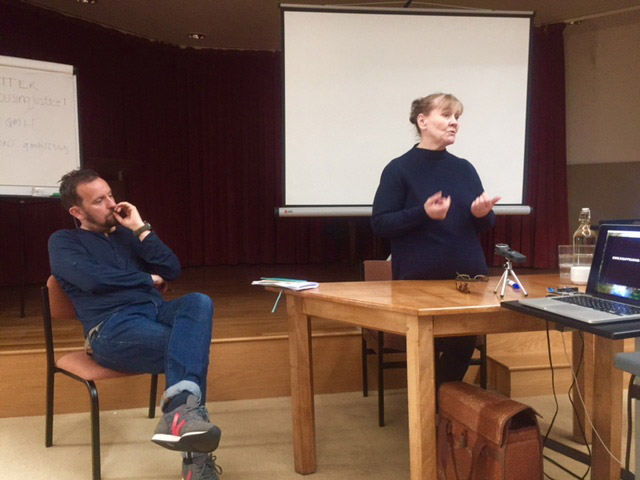
Margaret was entitled to compensation but didn’t want to move away from the area where she obviously had many ties. She did in fact want a small house in Dalmarnock which the Council were not prepared to give her. Margaret found a solicitor to help her attain this but unfortunately he was told by the council that they wouldn’t give him anymore work if he helped her so she was let down by him. She fought the QC (Queen’s Counsel) and applied to take her case to the European Court but due to the lawyer filling in the paper work wrong this failed.
Margaret was left with nothing “Nae legacy”, is still homeless and staying with her son. The site of her old home is a school playground now and the area is still derelict with no shops. Property developers who are in cahoots with the council sit on the land for years to make a profit..land banking. There was no public enquiry and Margaret was finally evicted by 120 police at 3.40am one morning. She now works tirelessly to help others to save their homes.
Filmmaker Chris Leslie made a 10 minute film about Margaret’s plight which was shown. His project and best selling photo book Disappearing Glasgow documents the changing face of the city.
Resisting Demolition : Art and Activism
Nina Edge, Artist and Welsh Streets Campaign
Janet Brandon, Artist and Filmmaker – https://vimeo.com/trickfilm
Janet Brandon
Janet showed a film she had made with Jayne Lawless called Without These Walls. The film starts with an animation of houses in Anfield where Jayne’s family home was. Janet built cardboard models of entire streets and these were turned into lifelike settings with abstract glowing light of orange and yellow representing cosy, lit up, warm domestic interiors. She added the sounds of family noises coming from each house and moved the film camera along the rows of houses, zooming in now and then. You really got the sense of a genuine community in these few streets. Then the animation turns real as real film of these real houses being visited by a bulldozer destroys any hope of saving them. These houses were demolished after many years of managed decline partly to make way for an extension to Liverpool Football Club’s stadium to maximise profit. Scores of once decent homes all gone.
The first showing of the film was screened at the demolition zone and locals came to view it. It was a cathartic experience with the former residents introducing themselves to each other with their old addresses.
Nina Edge
Nina started her talk along with photos by telling us about Liverpool’s Housing Market Renewal scheme to compulsory purchase and flatten the Welsh Streets and Granby area of Toxteth L8 and also the Anfield area. Originally there were about 8 campaigns going to save the homes. People were being forced out of their bought or rented homes. Some were offered £40,000 compensation for their well kept houses even though they had to pay £120,000 for a new property.
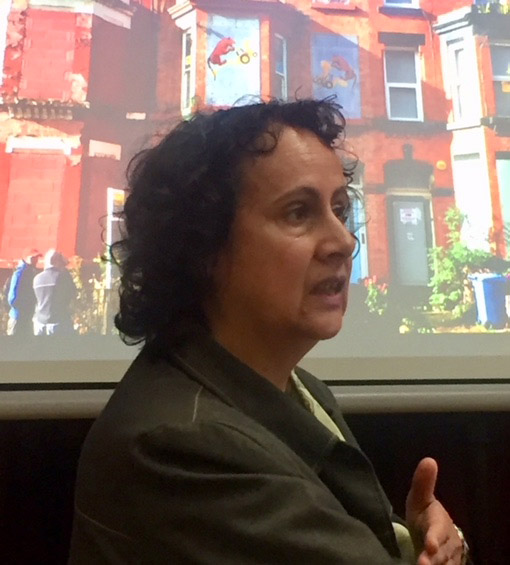
It was a serious issue for black and brown skinned people as L8 was an area where they had felt safe due to it being a very mixed area with a good community spirit and so it was difficult for them to be rehoused. Nina worked incredibly hard with her campaigning and sadly also had to deal with some of the residents objecting. They were desperate to leave after up to 30 years living in neglected, derelict and run down streets strewn with rubbish and wanted the houses demolished.
Those who weren’t prepared to be kicked out and uprooted developed manifestos like ‘a house for a house’ in the area. People got asset stripped and were dismayed and angry. Those who remained got the ”sharp fist of neo liberal economics”. Elizabeth Pascoe was the last resident occupying her home in the similar Edge Lane demolitions after the people there were being kicked out..She was told “We will issue CPO’s on your homes until we kill you”.
Nina even stood for local election, locals chipping in to pay for leaflet printing, knowing she would never be elected but raising awareness of the Welsh Streets plight. “Liverpool Party Stop demolishing. Start renovating, your right to a home is taken away”. She also turned the windows of her home into an exhibition/protest. Nina blocked all her front house windows out to look as if they were tinned up and put images on them including tigers fighting back bulldozers and house keys. She also erected lots of estate agent ‘house for sale’ signs on posts in front of her house but with ‘save the houses’ type texts on them instead. Liverpool Art Biennial had erected a giant boulder in a nearby street (costing £23,000 to ship from Spain) which was bringing in lots of visitors so why not draw them in to a local resident’s artwork!! She got lots of visitors.
800 daffodils were planted in the streets for Liverpool’s 800th birthday “You can effect change if you get your hands dirty”. Every one of the 300 empty houses was flyposted anonymously by someone at 4am with poems at one point. Joe Anderson and Grant Shapps even pretended to ITV news they had saved Ringo Starr’s house in Madryn Street but were met by locals outside on a tip off who said otherwise.
An organisation called Design Diplomacy made up of ‘constructive thinking architects’ discovered the houses could be refurbished for the same price as being demolished. Liverpool council dropped the value of the houses and sold the site off to PLACEFIRST for a very small amount even though lots of others had tried to get the streets but failed.
Wynnstay Street has now been renovated. The area was 74% social rental or housing association but not even housing co-ops can buy them now. The human cost has been immeasurable. “All behaviour around homes and communities are upside down”. Unfortunately most people who were dispersed can’t afford to rent them although 70% who can afford to are L8 people. Powys St was used for the TV series Peaky Blinders and is currently behind fences being done up.
Mobilising Homelessness Action
Jon Glackin, Streets Kitchen
Steve Speed, Salford Star
Jon Glackin
Jon runs Streets Kitchen a ‘Solidarity not Charity’ organisation to support the homeless. They run in various UK cities with no funding, just donations, of food, clothes and bedding etc. for those on the streets. They are out on the streets with hot meals and support for rough sleepers and other vulnerable people. “If charity had worked for the homeless, why are they still going 50 years later?”
The government have a flawed gathering of info and keep setting bullshit targets. Only ‘bedded down’ homeless count and those in an alley, park, squat or sofa surfing are not counted. There are 70 homeless in London’s Finsbury Park alone. A possible 8,000 rough sleepers in London now.
Charities like St. Mungo’s profit from homelessness and can’t speak freely or they will lose their funding. Streetlink were audited by Crisis and seen to have a less than 5% success rate of finding accommodation and they also report people to the Home office if they are migrants. It is a failed policy. Streetlink are not allowed to access services for the homeless. There is a need for more homeless community voices. Service users know what’s going on and are able to speak about it.
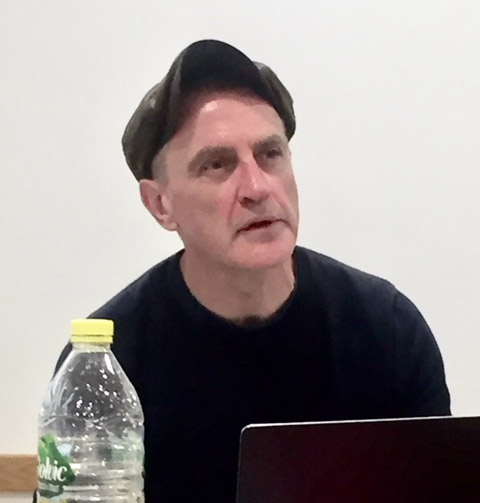
When the Beast from the East cold and snow hit London recently Street Kitchens opened up the long term empty Sofia House in London’s West End. They gave food and sleeping bags out and had up to 200 homeless staying at the end.There were even guerrilla paramedics helping out sick people.They have worked with Quakers and Housing Justice to try and double winter shelters. Streetlink also think more churches should give up space. Streets Kitchen had lost another building only the day before, this one in Hackney Wick, after 3 weeks occupation by rough sleepers.
Last Christmas day Jon took over Euston Station along with the help of Network Rail and provided dinner for around 200 homeless. The London Anarchist Bookfair had kindly raised £1,000 at an afterparty to pay for the food.
Housing First was set up in the US around 30 years ago and it believes people should be given a home first and then support services. This would give people in need the chance to get some stability in their lives. New Zealand claim a Housing First action will eradicate homelessness there. Streets Kitchen bridge the gap between order and chaos. Universal Credit will roll out a Tsunami of homelessness.
Jon says he is hopeful about the future and there should be a grass roots conference of those who work with the homeless possibly in Manchester this August. Even though Streets Kitchen are seen by some as an irritant it is important communities come together. 2010 had the world’s first Homeless Day with people talking globally. Unfortunately it has now been hijacked by those wanting to profit from it.
Unfortunately there is a more hostile environment in the last 7 years or so regards to things like begging. We should just give the homeless money though, it is their choice how they spend it.
Steve Speed
Steve has been documenting social movements for 15 years and produces the community magazine Salford Star. Steve asks how effective is homeless and housing action and can it be more effective? How is activism directly related to housing? Decent homes for everybody should be a fundamental right. Activists in Manchester had been learning and understanding approaches to activism from various movements and actions including Occupy Manchester and anti fracking at Barton Moss.
After a Homeless Action march in Manchester April 2015 people tried to occupy the town hall. They then set up a camp in Albert Square as homelessness was a growing issue and there was more and more evidence of street living. The council tried to get them evicted so they moved their camp to another square. St.Peters. The homeless felt vulnerable and alienated. They were being urinated on and one man sleeping in his tent was lifted up, in the tent, and thrown in a canal. There was some university owned disused land under a flyover by Oxford Road so the campers moved there when homeless man Ryan McPhee built a shelter called ‘The Ark’. The council had no powers to evict them but put in place an injunction banning tents as they didn’t want homelessness visible on the streets. The camp eventually got evicted and violently destroyed.
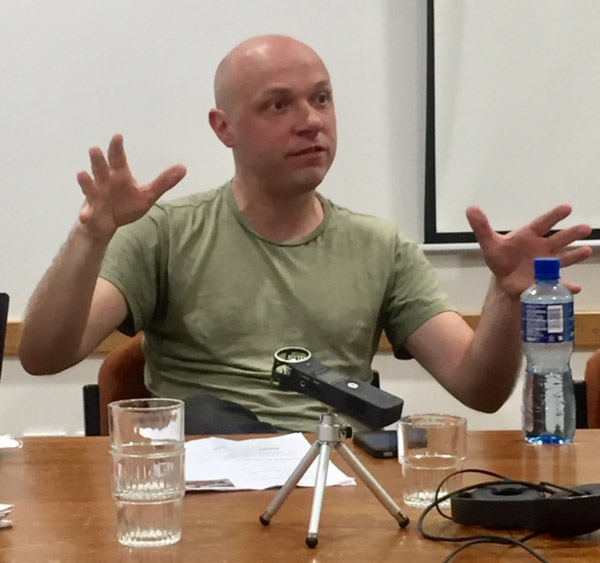
In Autumn 2015 there was a huge growth in activism in Manchester as a result of local and national government policies.The camps then moved indoors and occupied buildings. Gary Neville and Ryan Giggs allowed the homeless who occupied a building they owned to stay and didn’t try and get them evicted; they allowed them to stay with added support for 3 months over winter. Neville even provided security for them and regular meals from his hotel. it was a chance to wash, shower, feel safe and rebuild their lives.
Since 2015 and now there are many organisations helping the homeless but but campaigning has dropped off. April 2015’s march had between 300-500 on it but this year in April 2018 only 8 people marched. Lobbying needs to be more effective and more presence is needed in campaigns. There is a lack of council housing, the safety net is gone. Also gone is a sense of entitlement as everybody does have the right to a home.
Intersecting Housing Justice Campaigns
Ronnie Hughes, Granby 4 streets
Ronnie showed a film called ‘Home and Justice’ a Granby Story. He told of some of the history of the area. Liverpool was an original sailor town and people lived by the ships around the Pitt Street area. After bombs were dropped during WW2 people moved a mile up the road to the Granby area where some lived in massively overcrowded houses. There were a lot of problems in the area and eventually this led to an uprising in 1981. There was a municipal decision to clear Granby. This diaspora spread people all over the city and in the 90’s there was a big push to get rid of streets in the area. There were only 4 left eventually and the council wanted to put a big fence around them.
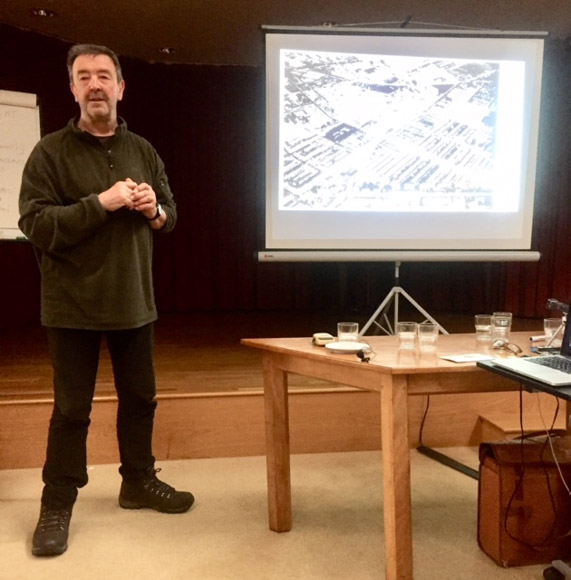
Ronnie was asked to help get involved in saving houses. Only 34 houses were being lived in as the residents didn’t want to leave. The occupiers began to clear rubbish and do gardening to make the streets look lived in and attractive. On Cairns Street’s boarded up windows they painted curtains, vases of flowers and cats, and soon the street attracted visitors from all over the world to view the guerrilla gardening which filled most front gardens with flowers and the length of the pavement with planting boxes, shrubs and flowers in pots and a picnic table and chairs.
Granby street market was started in Cairns Street to cheer everyone up and became busier and more successful. It was very crucial to the campaigning as the people were a very efficient force. Films were made of meetings and 100’s would turn out to watch. Even politicians got involved and housing associations were pulled back in. Half a million pounds was raised by the residents with a loan and a Community Land Trust was set up which attracted more media. The future of Granby was talked about ‘These are the people of the place and this is what the people want’. The scaffolding went up and finally victory as houses started to be renovated. People involved changed roles so as not to be burnt out. Ronnie produced photos and a blog and became the site manager. Architects and artists group Assemble had a good design for the houses and won the art world’s Turner prize in 2015.
The Community Land Trust managed to renovate 11 houses which cost £80,000 for each one and sold a few to pay back the loan. Housing Associations renovated even more. There was 5% public funding from the Nationwide Foundation. The CLT now owned 13 houses and 4 shops. 2/3rd’s of the houses went to first houses, the overcrowded or children of those pushed out. There is a Winter Garden being built from 2 houses which were too far gone to be renovated. It will be a community gathering place with a glass roof and gardening inside. Granby market is now based in Granby Street, is growing rapidly and hoped eventually to stretch the whole length of the road. An alternative economy started from ground zero..’by the people for the people’.
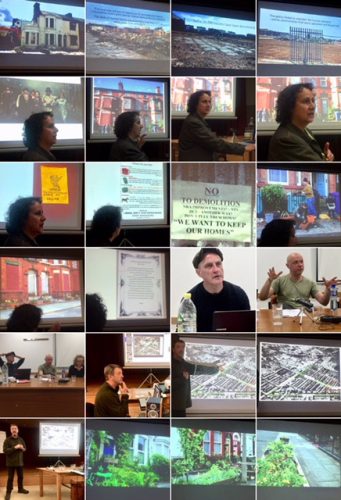
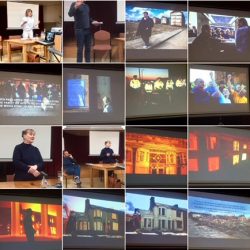
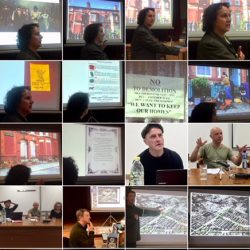
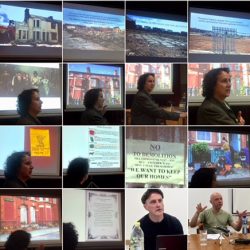
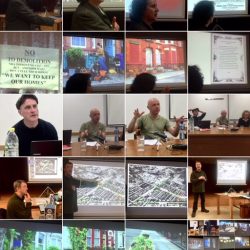
Permalink
tres bien excellent reporting
hopefully ill cover day two of conference missed day one
just redrafting it now short n sweet 2 films plus spkrs reports.